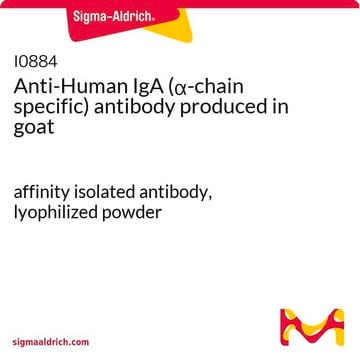おすすめの製品
由来生物
mouse
品質水準
抗体製品の状態
ascites fluid
抗体製品タイプ
primary antibodies
クローン
130-12H, monoclonal
131-2G, monoclonal
133-1H, monoclonal
化学種の反応性
human
メーカー/製品名
Chemicon®
テクニック
ELISA: suitable
immunofluorescence: suitable
アイソタイプ
IgG
輸送温度
wet ice
詳細
RSVは不安定なパラミクソウイルスで、組織培養においてヒト細胞の特徴的な融合を引き起こします(合胞体効果)。AとBの2つのサブタイプが同定されています。サブタイプBは、ウイルスの無症候性株であることがわかっています。重度の臨床疾患には、サブタイプA株が関与します。
特異性
MAB858-1、2、3のすべてのRSV規格のブレンド。AおよびB株の融合、G、核タンパク質を認識します。
免疫原
A2
アプリケーション
1:800+でのELISA
1:100-200+での間接的免疫蛍光染色(新鮮凍結組織切片)
最終的な希釈濃度は、ご自身で決定してください。
1:100-200+での間接的免疫蛍光染色(新鮮凍結組織切片)
最終的な希釈濃度は、ご自身で決定してください。
抗RSV抗体、blend、クローン133-1H、131-2G、130-12Hは、呼吸器合胞体ウイルスに対する抗体であり、IF、ELISAに使用できます。
研究のカテゴリー
感染性疾患
感染性疾患
研究のサブカテゴリー
感染性疾患-ウイルス性
感染性疾患-ウイルス性
物理的形状
未精製
腹水液。
保管および安定性
-20℃で出荷日から1年間保存できます。凍結融解を繰り返さないために、分注してください。製品を最大限回収するために、融解後のキャップを外す前に元のバイアルを遠心分離します。
アナリシスノート
コントロール
RSVコントロールスライド、カタログ番号5012-5
RSVコントロールスライド、カタログ番号5012-5
その他情報
濃度:ロットに固有の濃度につきましては試験成績書をご参照ください。
法的情報
CHEMICON is a registered trademark of Merck KGaA, Darmstadt, Germany
免責事項
メルクのカタログまたは製品に添付されたメルクのその他の文書に記載されていない場合、メルクの製品は研究用途のみを目的としているため、他のいかなる目的にも使用することはできません。このような目的としては、未承認の商業用途、in vitroの診断用途、ex vivoあるいはin vivoの治療用途、またはヒトあるいは動物へのあらゆる種類の消費あるいは適用などがありますが、これらに限定されません。
Not finding the right product?
Try our 製品選択ツール.
保管分類コード
12 - Non Combustible Liquids
WGK
nwg
引火点(°F)
Not applicable
引火点(℃)
Not applicable
適用法令
試験研究用途を考慮した関連法令を主に挙げております。化学物質以外については、一部の情報のみ提供しています。 製品を安全かつ合法的に使用することは、使用者の義務です。最新情報により修正される場合があります。WEBの反映には時間を要することがあるため、適宜SDSをご参照ください。
Jan Code
MAB858-4:
試験成績書(COA)
製品のロット番号・バッチ番号を入力して、試験成績書(COA) を検索できます。ロット番号・バッチ番号は、製品ラベルに「Lot」または「Batch」に続いて記載されています。
Talita Bianca Gagliardi et al.
Intervirology, 60(1-2), 56-60 (2017-09-05)
Syncytia formation is the hallmark of the cytopathic effect caused by human respiratory syncytial virus (HRSV), which is the most important viral respiratory pathogen in children. This article reports methodological improvements in primary HRSV isolation and the importance of syncytia
Tiina Talts et al.
Microbiology spectrum, 12(4), e0306723-e0306723 (2024-02-27)
Prevention of respiratory syncytial virus (RSV) infection is now a global health priority, with a long-acting monoclonal antibody and two RSV vaccines recently licenced for clinical use. Most licenced and candidate interventions target the RSV fusion (RSV-F) protein. New interventions
John P DeVincenzo et al.
The Journal of infectious diseases, 190(5), 975-978 (2004-08-06)
Premature infants and those with chronic lung disease or congenital heart disease are at high risk of severe respiratory syncytial virus (RSV) disease. Palivizumab (Synagis), a humanized anti-RSV monoclonal antibody, has been used extensively since 1998 to prevent severe RSV
Ziyin Wang et al.
Mucosal immunology, 17(2), 272-287 (2024-02-22)
Respiratory viral infections remain a major cause of hospitalization and death worldwide. Patients with respiratory infections often lose weight. While acute weight loss is speculated to be a tolerance mechanism to limit pathogen growth, severe weight loss following infection can
Hayat Caidi et al.
Methods in molecular biology (Clifton, N.J.), 1442, 13-32 (2016-07-29)
Defective interfering viral particles have been reported as important determinants of the course of viral infection, and they can markedly temper the virulence of the infection. Here, we describe a simple method, based on limiting dilution, for the removal of
ライフサイエンス、有機合成、材料科学、クロマトグラフィー、分析など、あらゆる分野の研究に経験のあるメンバーがおります。.
製品に関するお問い合わせはこちら(テクニカルサービス)




